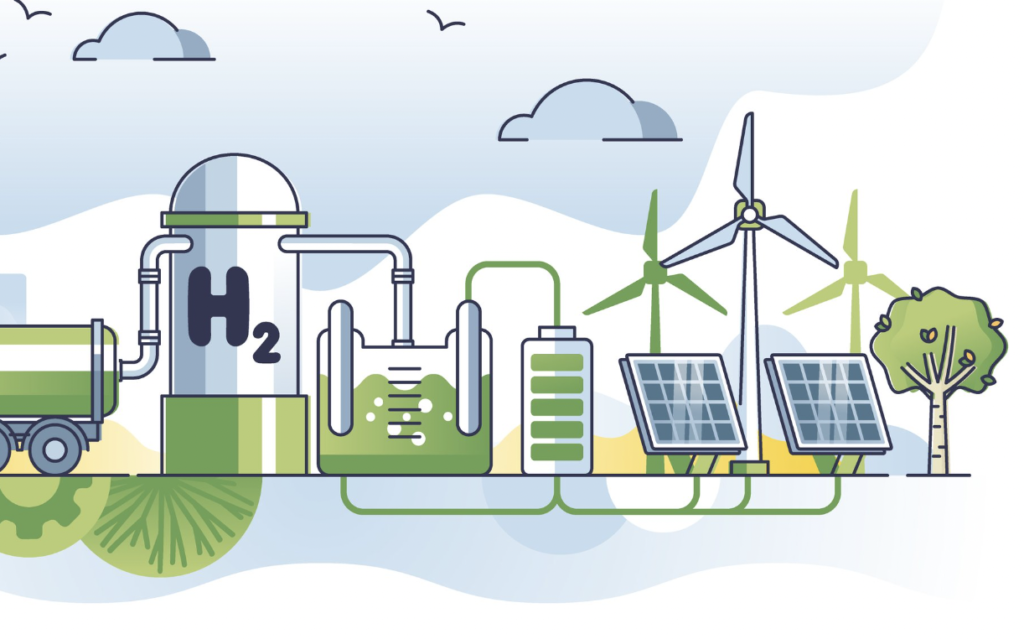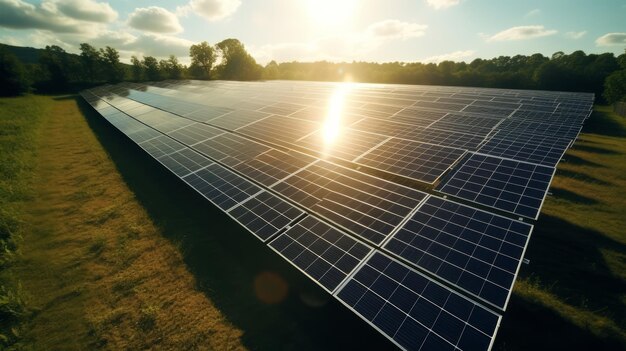
Hydrogen Fuel Cells: The Next Big Thing in Clean Energy?
The world is on a relentless quest for cleaner, more sustainable energy. With climate change knocking on our door, the urgency to move away from fossil fuels has never been greater. While solar panels and wind turbines are becoming increasingly common, the challenge of reliable energy storage and heavy-duty transportation remains. Enter Hydrogen Fuel Cells – a technology that’s quietly, but powerfully, positioning itself as a potential game-changer in the clean energy landscape.
But what exactly are hydrogen fuel cells? How do they work? And are they truly the "next big thing" or just another promising idea on the horizon? Let’s dive in.
What Exactly Are Hydrogen Fuel Cells? A Simple Explanation
Imagine a battery that never runs out, as long as it has fuel. That’s essentially what a hydrogen fuel cell is. Unlike traditional batteries that store energy and eventually need recharging from an external source, a fuel cell produces electricity through a chemical reaction, as long as it’s continuously supplied with fuel (hydrogen) and an oxidant (oxygen from the air).
Here’s the magic in a nutshell:
- Hydrogen (H₂) goes in.
- Oxygen (O₂) from the air goes in.
- Inside the fuel cell, these two elements combine in a controlled chemical reaction.
- This reaction generates electricity (which powers whatever is connected) and pure water (H₂O) as the only byproduct.
Think of it like an "un-combustion" engine. Instead of burning fuel to create heat and mechanical energy (like in a gasoline car), a fuel cell "oxidizes" hydrogen to create electricity directly, with no harmful emissions whatsoever.
Key Components of a Fuel Cell:
- Anode (Negative Electrode): Where hydrogen enters and is split into protons and electrons.
- Cathode (Positive Electrode): Where oxygen enters and combines with protons and electrons to form water.
- Electrolyte (Membrane): A special material (often a Proton Exchange Membrane, or PEM) that only allows positively charged hydrogen ions (protons) to pass through. It forces the electrons to take an external circuit, creating the flow of electricity.
This elegant process is what makes hydrogen fuel cells so appealing in the race for zero-emission technologies.
Why Are Hydrogen Fuel Cells So Exciting? The Undeniable Benefits
The potential advantages of hydrogen fuel cells are compelling, addressing many of the limitations of existing clean energy solutions:
- Zero Emissions at the Tailpipe/Point of Use: This is the biggest draw. When a fuel cell operates, the only byproduct is water vapor. No greenhouse gases, no smog-forming pollutants, no particulate matter. This means cleaner air, especially in urban areas.
- High Efficiency: Fuel cells convert chemical energy directly into electrical energy, often achieving higher efficiencies than traditional internal combustion engines, which lose a lot of energy as heat.
- Fast Refueling: Unlike battery electric vehicles (BEVs) that can take 20 minutes to several hours to charge, hydrogen fuel cell vehicles (FCEVs) can be refueled in minutes – comparable to filling up a gasoline car. This is a massive advantage for long-haul transport and commercial fleets.
- Long Range Capability: For a given weight, hydrogen can store more energy than even the most advanced batteries. This translates to longer driving ranges for vehicles and extended operating times for stationary power applications, making them suitable for heavy-duty trucks, buses, trains, and even ships and aircraft.
- Scalability & Versatility: Fuel cells can be stacked together to create larger power plants, or scaled down for smaller applications. They can power everything from forklifts and cars to entire buildings and data centers.
- Quiet Operation: Since there’s no combustion, fuel cells operate very quietly, which is beneficial for urban transport and residential power generation.
- Energy Storage Potential: Hydrogen itself can be a fantastic way to store excess renewable energy (like from solar or wind farms) that isn’t immediately used. This "green hydrogen" can then be converted back into electricity via fuel cells when needed, helping to balance the grid.
Where Will We See Hydrogen Fuel Cells in Action? Diverse Applications
The versatility of fuel cell technology means it’s not just limited to cars. Its potential applications span a wide range of sectors:
- Transportation:
- Cars: Models like the Toyota Mirai and Hyundai Nexo are already on the road, offering long range and quick refueling.
- Buses & Trucks: Ideal for commercial fleets that need to operate continuously and cover long distances. Many cities are piloting hydrogen buses.
- Trains: Several countries are developing hydrogen-powered trains, offering a clean alternative to diesel locomotives on non-electrified lines.
- Maritime & Aviation: Early concepts and prototypes for hydrogen-powered ships and aircraft are being explored, addressing the immense energy needs of these sectors.
- Forklifts & Material Handling: Already widely adopted in warehouses due to their consistent power output and quick "refueling" compared to battery swaps.
- Stationary Power Generation:
- Backup Power: Providing reliable, emission-free power for critical infrastructure like hospitals, data centers, and telecommunication towers.
- Combined Heat and Power (CHP): Fuel cells can produce both electricity and useful heat, increasing overall efficiency for buildings and industrial sites.
- Grid Support: Helping to stabilize power grids by providing on-demand electricity, especially when renewable sources like solar or wind are intermittent.
- Industrial Applications:
- Providing clean power for heavy machinery or remote operations where grid connection is challenging.
- As a feedstock for industrial processes (e.g., ammonia production, steelmaking), offering a path to decarbonize these energy-intensive sectors when green hydrogen is used.
- Portable Power:
- Smaller fuel cells can power portable devices, drones, and even act as portable chargers where extended operation is needed.
The Roadblocks: Why Aren’t They Everywhere Yet?
Despite their incredible potential, hydrogen fuel cells face significant hurdles that prevent their widespread adoption today. These challenges are often interlinked:
- Hydrogen Production Methods (The "Green" Problem): This is perhaps the biggest elephant in the room. While fuel cells themselves produce zero emissions, the hydrogen fuel must be produced cleanly. Currently, the vast majority of hydrogen is produced from natural gas (a fossil fuel), a process that releases significant carbon dioxide. This is known as "grey hydrogen." The goal is to produce "green hydrogen" using renewable electricity to split water, but this is still more expensive and less scalable.
- Infrastructure (The Chicken-and-Egg Problem): Building a comprehensive network of hydrogen refueling stations is incredibly expensive and complex. There’s a "chicken-and-egg" situation: consumers won’t buy fuel cell cars if there’s no place to fill up, and companies won’t build stations if there aren’t enough cars.
- Cost: The manufacturing cost of fuel cells themselves, particularly the platinum catalysts often used, can be high. The cost of hydrogen fuel, especially green hydrogen, is also generally higher than gasoline or electricity.
- Hydrogen Storage & Transport: Hydrogen is the lightest element, meaning it’s very "fluffy." To store enough for practical use, it needs to be highly compressed (at very high pressures) or liquefied (at extremely low temperatures, -253°C). Both methods require significant energy and specialized, expensive equipment, making transport and storage challenging.
- Perception & Safety: While hydrogen is as safe as gasoline when handled correctly (and arguably safer in some respects due to its rapid dispersion), public perception can be influenced by historical events (like the Hindenburg disaster) or a general unfamiliarity with the gas. Education is key.
- Overall System Efficiency: While the fuel cell itself is efficient, the entire "well-to-wheel" or "source-to-power" efficiency of hydrogen can be lower than battery electric vehicles, especially if the hydrogen is produced from electricity and then converted back to electricity. This is because energy is lost at each conversion step (production, compression/liquefaction, and then in the fuel cell).
Hydrogen’s Color Palette: Understanding Production Methods
To truly understand the "clean" potential of hydrogen, it’s crucial to know how it’s produced. The industry uses a "color" code to denote the source and associated emissions:
- Grey Hydrogen:
- Source: Steam methane reforming (SMR) from natural gas (a fossil fuel).
- Emissions: Significant CO₂ emissions are released into the atmosphere.
- Current Status: Accounts for the vast majority (around 95%) of global hydrogen production today. Not considered a clean energy solution on its own.
- Blue Hydrogen:
- Source: Also from natural gas, but with Carbon Capture, Utilization, and Storage (CCUS) technology.
- Emissions: CO₂ emissions are captured and stored underground, reducing the climate impact, but not eliminating it entirely (some emissions still occur).
- Current Status: Seen as a transitional step towards truly clean hydrogen, especially in regions with abundant natural gas.
- Green Hydrogen:
- Source: Electrolysis of water using 100% renewable electricity (solar, wind, hydro).
- Emissions: Zero greenhouse gas emissions during production. The "holy grail" of clean hydrogen.
- Current Status: Still relatively expensive and small-scale, but rapidly gaining investment and research focus. This is the hydrogen that makes fuel cells a truly clean energy solution.
- Pink/Yellow Hydrogen:
- Source: Electrolysis of water using electricity from nuclear power plants.
- Emissions: Zero greenhouse gas emissions during production.
- Current Status: Gaining interest as a stable, carbon-free source of electricity for hydrogen production.
- Turquoise Hydrogen:
- Source: Methane pyrolysis, splitting methane into hydrogen and solid carbon (instead of CO₂).
- Emissions: No CO₂ emissions, as carbon is captured in solid form.
- Current Status: Still in early stages of development.
The long-term vision for hydrogen fuel cells relies heavily on the scalable and cost-effective production of green hydrogen. Without it, fuel cells are merely shifting emissions upstream rather than eliminating them.
The Future of Hydrogen: A Promising Path Forward?
Despite the challenges, the momentum behind hydrogen fuel cells is undeniable. Governments worldwide are investing heavily in hydrogen strategies, research, and infrastructure development. Industries are forming partnerships to accelerate progress, and technological advancements are continuously driving down costs and improving efficiency.
- Declining Costs: The cost of electrolyzers (for green hydrogen production) and fuel cell stacks is projected to fall significantly over the next decade as manufacturing scales up and technologies mature.
- Policy Support: Many countries are setting ambitious targets for hydrogen production and deployment, offering incentives and funding for projects.
- Technological Breakthroughs: Researchers are exploring new materials for fuel cells, more efficient electrolysis methods, and safer, denser hydrogen storage solutions.
- Sectoral Decarbonization: Hydrogen is increasingly seen as crucial for decarbonizing "hard-to-abate" sectors like heavy industry, shipping, and aviation, where direct electrification is difficult or impractical.
- Synergy with Renewables: Hydrogen can act as a bridge between intermittent renewable energy sources and consistent energy demand, helping to build a more resilient and sustainable energy system.
Conclusion: A Crucial Piece of the Clean Energy Puzzle
So, are hydrogen fuel cells the "next big thing" in clean energy? The answer is nuanced, but largely optimistic. They are unlikely to be the only solution, but they are undoubtedly a crucial and indispensable piece of the future clean energy puzzle.
For applications requiring long range, fast refueling, heavy loads, or consistent power where batteries fall short, hydrogen fuel cells offer a compelling, zero-emission alternative. The journey to widespread adoption will require continued innovation, significant infrastructure investment, and, most critically, a massive scale-up of green hydrogen production.
As the world strives for a carbon-neutral future, hydrogen fuel cells stand ready to play a pivotal role, driving us towards a cleaner, more sustainable tomorrow. They might not be the next big thing, but they are certainly a next big thing, deserving of our attention and investment as we navigate the energy transition.



Post Comment